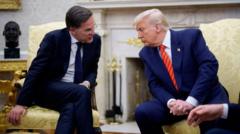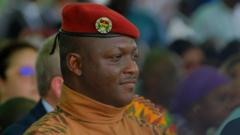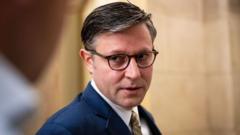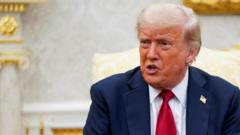As the alliance prepares to meet, tensions remain regarding defense spending and responses to Russia's actions, casting a shadow over discussions.
**NATO Summit: America's Influence Looms Large Over Allies**

**NATO Summit: America's Influence Looms Large Over Allies**
The upcoming NATO summit in The Hague is poised to focus primarily on U.S. demands, particularly from President Trump, while downplaying divisions among member nations.
Despite being attended by 32 nations, the NATO summit in The Hague has swiftly become a stage largely set by U.S. President Donald Trump. Secretary General Mark Rutte aims to appease the U.S. by presenting a united front, with a central focus on boosting defense expenditures by European allies, a demand Trump has persistently championed since his first term.
In a departure from traditional NATO summit proceedings, which typically allow for extensive discussions, the upcoming meeting will be brief—limited to just three hours—with the final statement condensed to five concise paragraphs. This shift is largely viewed as a strategy to cater to Trump’s preferences, with his administration historically expressing skepticism towards multinational organizations like NATO.
Security measures in The Hague reflect the summit's significance, with Dutch authorities implementing their largest-ever security operation, motivated by the costly sum of €183.4 million for the event. The main sticking point remains the discrepancy in defense spending between the U.S. and European nations. For many allies, the push to increase spending to a target of 3.5% of GDP—layered with another 1.5% for defense-related expenditures—has been met with mixed responses. Some European nations are already on board, particularly those bordering Russia, yet meeting these ambitious spending goals remains a formidable challenge.
While Trump's emphasis on raising NATO budgets has prompted some positive responses, critics suggest that a vague definition of what constitutes "defense-related" spending could lead to ambiguity in its application. Countries like Spain have already expressed skepticism, with concerns regarding the feasibility of maintaining such spending commitments amidst broader economic considerations.
Additionally, while Russia's aggressive posture towards Ukraine looms large, specific discussions about the conflict have been sidelined in the summit's agenda, signaling a divide between U.S. and European perspectives on security strategies. The divergent views on Ukraine's security underscore the complexities facing NATO amid shifting geopolitical landscapes.
In a peculiar turn of events, invitations have also been extended to Ukrainian President Volodymyr Zelensky for the summit dinner, yet he remains excluded from primary discussions within the North Atlantic Council—an absence that highlights the ongoing tensions surrounding NATO's collective approach to Russia.
With Trump’s presence coloring the forum, it appears that this NATO summit, rather than uniting member states, will further spotlight the chasms in policy and priorities within the Alliance, primarily driven by U.S. objectives. As Rutte hopes for a smooth summit experience, the historical friction between Trump and various European leaders could complicate discussions on urgent defense strategies.
In a departure from traditional NATO summit proceedings, which typically allow for extensive discussions, the upcoming meeting will be brief—limited to just three hours—with the final statement condensed to five concise paragraphs. This shift is largely viewed as a strategy to cater to Trump’s preferences, with his administration historically expressing skepticism towards multinational organizations like NATO.
Security measures in The Hague reflect the summit's significance, with Dutch authorities implementing their largest-ever security operation, motivated by the costly sum of €183.4 million for the event. The main sticking point remains the discrepancy in defense spending between the U.S. and European nations. For many allies, the push to increase spending to a target of 3.5% of GDP—layered with another 1.5% for defense-related expenditures—has been met with mixed responses. Some European nations are already on board, particularly those bordering Russia, yet meeting these ambitious spending goals remains a formidable challenge.
While Trump's emphasis on raising NATO budgets has prompted some positive responses, critics suggest that a vague definition of what constitutes "defense-related" spending could lead to ambiguity in its application. Countries like Spain have already expressed skepticism, with concerns regarding the feasibility of maintaining such spending commitments amidst broader economic considerations.
Additionally, while Russia's aggressive posture towards Ukraine looms large, specific discussions about the conflict have been sidelined in the summit's agenda, signaling a divide between U.S. and European perspectives on security strategies. The divergent views on Ukraine's security underscore the complexities facing NATO amid shifting geopolitical landscapes.
In a peculiar turn of events, invitations have also been extended to Ukrainian President Volodymyr Zelensky for the summit dinner, yet he remains excluded from primary discussions within the North Atlantic Council—an absence that highlights the ongoing tensions surrounding NATO's collective approach to Russia.
With Trump’s presence coloring the forum, it appears that this NATO summit, rather than uniting member states, will further spotlight the chasms in policy and priorities within the Alliance, primarily driven by U.S. objectives. As Rutte hopes for a smooth summit experience, the historical friction between Trump and various European leaders could complicate discussions on urgent defense strategies.




















